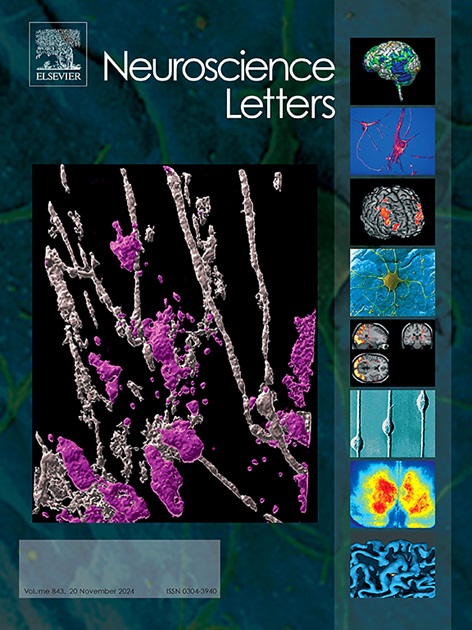Absence of a glutamatergic channel arrest mechanisms in hypoxic naked mole-rat cortex
IF 2.5
4区 医学
Q3 NEUROSCIENCES
引用次数: 0
Abstract
In the brain of hypoxia-intolerant vertebrates, hypoxia induces neuronal depolarization, chronic activation of voltage-gated excitatory glutamatergic receptors, and rapid accumulation of Ca2+ in the cytosol, which induces downstream activation of cell death pathways. Conversely, deleterious Ca2+ accumulation and cell death is avoided in the brain of hypoxia-tolerant vertebrates. One neuroprotective adaptation that is present in some of the most hypoxia-tolerant vertebrates is channel arrest, whereby Ca2+ ion influx through glutamate receptors is reduced in hypoxia, and cytotoxic accumulation of Ca2+ is avoided. Naked mole-rats are a hypoxia-tolerant mammal and avoid neurotoxic Ca2+ accumulation during hypoxia; however, the underlying mechanisms are poorly understood. In the present study, we tested the hypothesis that channel arrest of glutamatergic receptors occurs in hypoxic naked mole-rat neurons, which would help to limit Ca2+ influx during hypoxia. Using the Ca2+-sensitive fluorophore Fura-2, we measured Ca2+ flux through glutamatergic receptors in live brain slices exposed to a normoxic or hypoxic (1 % O2) perfusate and following application of either glutamate or NMDA to stimulate glutamatergic receptors. We found no differences in the magnitude of the evoked Ca2+ transients or the total amount of Ca2+ movement following ligand stimulus. Our results indicate that channel arrest is not an important strategy to limit deleterious Ca2+ influx into naked mole-rat neurons during hypoxia. Other mechanisms, such as enhanced mitochondrial buffering of cytosolic Ca2+, may play a more important role in hypoxic Ca2+ homeostasis in this species.
缺氧裸鼹鼠皮质谷氨酸通道阻滞机制的缺失
在缺氧不耐受的脊椎动物的大脑中,缺氧诱导神经元去极化,电压门控兴奋性谷氨酸受体的慢性激活,以及细胞质中Ca2+的快速积累,从而诱导下游细胞死亡途径的激活。相反,在耐缺氧脊椎动物的大脑中,有害的Ca2+积累和细胞死亡是避免的。在一些最耐缺氧的脊椎动物中存在的一种神经保护性适应是通道阻滞,通过谷氨酸受体的Ca2+离子内流在缺氧中减少,并且避免了Ca2+的细胞毒性积累。裸鼹鼠是一种耐缺氧哺乳动物,在缺氧时避免神经毒性Ca2+积累;然而,人们对其潜在机制知之甚少。在本研究中,我们测试了一个假设,即在缺氧裸鼹鼠神经元中发生谷氨酸能受体的通道阻滞,这将有助于限制缺氧时Ca2+的内流。使用Ca2+敏感荧光团Fura-2,我们测量了暴露于常氧或缺氧(1% O2)灌注和应用谷氨酸或NMDA刺激谷氨酸能受体后的活脑切片中通过谷氨酸能受体的Ca2+通量。我们发现在诱发Ca2+瞬态的大小或配体刺激后Ca2+运动的总量没有差异。我们的研究结果表明,通道阻滞不是一个重要的策略,以限制有害的Ca2+流入裸鼹鼠神经元在缺氧。其他机制,如增强线粒体对细胞质Ca2+的缓冲,可能在该物种的缺氧Ca2+稳态中发挥更重要的作用。
本文章由计算机程序翻译,如有差异,请以英文原文为准。
求助全文
约1分钟内获得全文
求助全文
来源期刊

Neuroscience Letters
医学-神经科学
CiteScore
5.20
自引率
0.00%
发文量
408
审稿时长
50 days
期刊介绍:
Neuroscience Letters is devoted to the rapid publication of short, high-quality papers of interest to the broad community of neuroscientists. Only papers which will make a significant addition to the literature in the field will be published. Papers in all areas of neuroscience - molecular, cellular, developmental, systems, behavioral and cognitive, as well as computational - will be considered for publication. Submission of laboratory investigations that shed light on disease mechanisms is encouraged. Special Issues, edited by Guest Editors to cover new and rapidly-moving areas, will include invited mini-reviews. Occasional mini-reviews in especially timely areas will be considered for publication, without invitation, outside of Special Issues; these un-solicited mini-reviews can be submitted without invitation but must be of very high quality. Clinical studies will also be published if they provide new information about organization or actions of the nervous system, or provide new insights into the neurobiology of disease. NSL does not publish case reports.
 求助内容:
求助内容: 应助结果提醒方式:
应助结果提醒方式:


